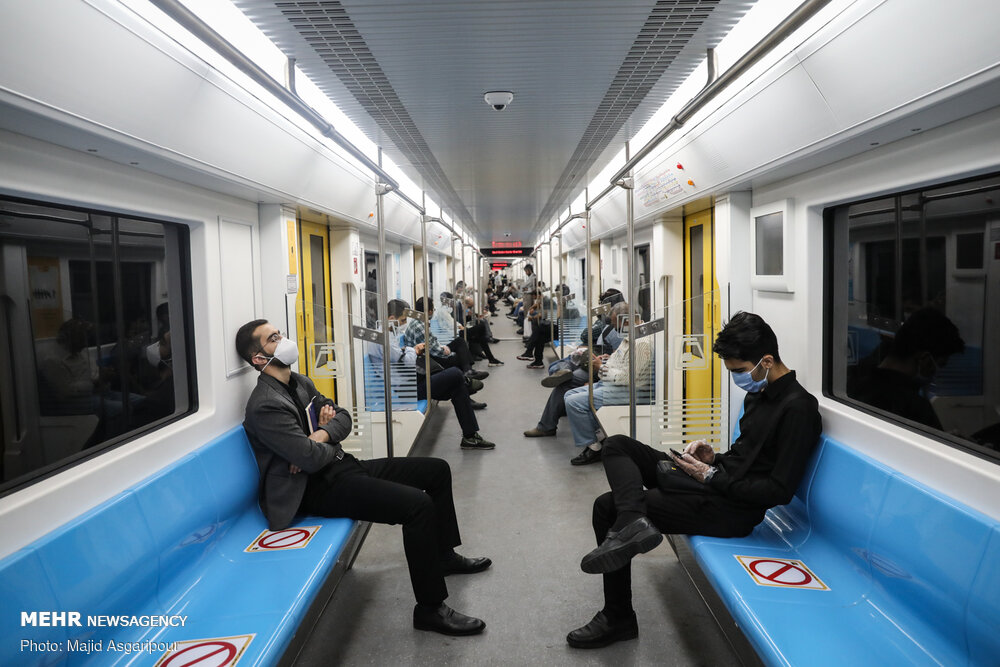The number of Covid-19 infections in the capital city of Tehran has hit an emergency level in the past several days, while a large number of residents commute to work using public means of transportation such as buses and the subway.
To take a measure against the spread of the virus, Iran's National Coronavirus Taskforce has called on responsible authorities to implement the second round of curbs on high-risk businesses and suspend traffic restrictions in Tehran, YJC reported.
In the first phase of shutdown, the government temporarily suspended restrictive traffic rules in Tehran for over two months until June 5. All businesses and shops, except essential ones such as food outlets, grocery stores and bakeries, were under lockdown until April 11 and inter-city traffic restrictions were implemented around the country.
Alireza Zali, the head of Iran's National Coronavirus Taskforce, suggested that traffic rules must be temporarily canceled and remote work permits should be considered for office employees.
"Online shopping should be promoted to minimize unnecessary travels in the city. These actions can also curb the increased use of public transportation services," he said.
Zali said 44% of people in the capital city use public transportation or private cars to commute to their workplaces, while 25% of citizens leave home every day for necessary and unnecessary shopping.
"Around 62% of commuters believe social distancing is poorly observed in public transportation vehicles, especially subway trains," he added, urging urban managers to devise a solution or at least resume the previously implemented measures.
Tehran Mayor Pirouz Hanachi, however, said the traffic rules were canceled for two months until June 6, showing an insignificant effect on reducing crowding in the subway and buses.
"Social distancing is only possible in Tehran's public transport system if we triple the capacity," he said, adding that this is too ambitious at present, considering the economic headwinds faced by Tehran Municipality and the government.
What to Do
Tehran Metro CEO Farnoush Nobakht has warned people against undertaking outdoor activities while urging commuters to use the subway in less crowded hours (7-8 a.m. and 1-2 p.m.) as far as possible.
He also urged the general public to use facemasks and stick to health protocols when using the subway as much as possible.
Since President Hassan Rouhani announced that wearing facemasks is obligatory in covered space as of July 5, the metro police are strictly monitoring the passengers, notifying those ignoring the rule.
Saeid Ataollahi, Tehran Metro police chief, said, "The police prevent passengers not wearing facemasks from passing through the entry gates and politely ask them to purchase one from the facemask stall in the metro lobby."
For passengers with financial problems, facemasks will be offered for free, he added.
The police chief noted that before the mandatory rule was announced, unfortunately, a number of subway commuters overlooked the importance of wearing masks.
"At present, over 90% of the passengers adhere to the face rule. This can exert a controlling effect on the Covid-19 spreading rate, as simply wearing a mask even in a partially crowded train wagon can majorly reduce the risk of getting infected."
Ataollahi emphasized that the strict measures are for the public good and for their own safety.
“Maximum care should be taken because the virus is still spreading and things could get worse before they get better,” he added.
Health Hazard
Health experts have repeatedly warned that the use of public transport can increase the risk of infection.
Senior officials issue daily warnings that the virus is spreading and the situation has worsened. However, the resumption of social activities is making it very difficult to reduce mortalities and the numbers of hospitalizations have been rising rapidly.
According to the Health Ministry, public vehicles are more polluted compared to universities and schools, so extra care should be taken by commuters.
Urban managers say the ventilation system in subway trains is concentrated, and the air inside cars is constantly circulating and combining with the air outside.
This means one sick person in a train can possibly pollute the air in all cars. The same is true in public buses.
By July 15, the virus has infected 262,173 people in the country, of whom 13,211 have died. Based on the Health Ministry's regular reports, 225,270 patients have recovered.
Solution to Current Shortfalls
In offering a solution for shortcomings, Mohsen Hashemi, chairman of Tehran City Council, had earlier said more vehicles should be added to the public transportation fleet.
That said, social distancing is impossible in a crowded city like Tehran that has spread in all four directions in the past half-century and is home to 10 million people.
In late February, the government intended to use the National Development Fund of Iran to help Tehran Municipality buy 630 subway cars.
The announcement was made in a meeting between Es’haq Jahangiri, first vice president, and Hashemi, where they discussed ways of expanding and improving public transport.
Mohammad Alikhani, the head of Tehran’s Transportation Commission, later told reporters that the government will allocate funds as soon as experts complete their estimations and select the companies.
Ali Emam, Tehran Metro’s CEO, told reporters that 16 train wagons will be added to the capital's subway by late July.
One thousand subway cars are in use in the capital's urban subway system, 30% of which need to be renovated. With the slow addition of new train cars, Tehran’s subway still seems far away from a decent means of public transportation.
The subway stretches over 220 kilometers and comprises seven lines (1 to 7) with 120 stations. Lines 6 and 7 are not yet fully operational.
On a normal day, over four million people use the subway. The municipality expects the numberto surge by 25% after the two remaining lines are completed.


